Related Research Articles
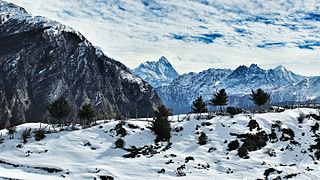
Uttarakhand, formerly known as Uttaranchal, is a state in northern India. The state is bordered by Himachal Pradesh to the northwest, Tibet to the north, Nepal to the east, Uttar Pradesh to the south and southeast, with a small part touching Haryana in the west. Uttarakhand has a total area of 53,483 km2 (20,650 sq mi), equal to 1.6% of the total area of India. Dehradun serves as the state capital, with Nainital being the judicial capital. The state is divided into two divisions, Garhwal and Kumaon, with a total of 13 districts. The forest cover in the state is 45.4% of the state's geographical area. The cultivable area is 16% of the total geographical area. The two major rivers of the state, the Ganges and its tributary Yamuna, originate from the Gangotri and Yamunotri glaciers respectively.

The Jaintia Kingdom was a kingdom in present-day some parts of Bangladesh's Sylhet Division, India's Meghalaya state and Nagaon, Morigoan district of Assam. It was partitioned into three in 630 AD by Raja Guhak for his three sons, into the Jaintia Kingdom, Gour Kingdom and Laur Kingdom. It was annexed by the British East India Company in 1835. All the Pnar Rajahs of the Jaintiapur Kingdom are from the Syiem Sutnga clan, a Pnar clan of the Khasi tribe which claims descent from Ka Li Dohkha, a divine nymph.

The Chand kingdom was a Rajput kingdom that ruled the Kumaon area in present-day Uttarakhand state of India, after the decline of the Katyuri kingdom. At times, their rule also extended to the western parts of present-day Nepal. Somchand established the dynasty, establishing his capital at Rajbunga in present-day Champawat.
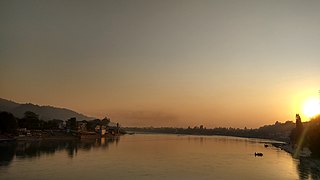
Dehradun district is a district in Garhwal which is a part of Uttarakhand state in northern India. The district headquarters is Dehradun, which has also served as the interim capital of Uttarakhand since its founding in 2000. The district has 6 tehsils, 6 community development blocks, 17 towns and 764 inhabited villages, and 18 unpopulated villages. As of 2011, it is the second most populous district of Uttarakhand, after Haridwar. Dehradun district also includes the prominent towns of Rishikesh, Mussoorie, Landour and Chakrata. The district stretches from the Ganges river in the east to the Yamuna river in the west, and from the Terai and Shivaliks in the south and southeast to the Great Himalaya in the northwest. During the days of British Raj, the official name of the district was Dehra Dun. In 1842, Dun was attached to Saharanpur district and placed under an officer subordinate to the Collector of the district but since 1871 it is being administered as separate district.
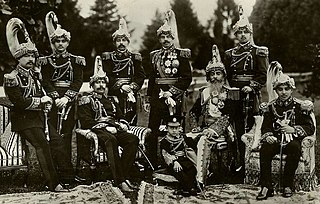
The Rana dynasty was a Chhetri dynasty that imposed authoritarianism in the Kingdom of Nepal from 1846 until 1951, reducing the Shah monarch to a figurehead and making the Prime Minister and other government positions held by the Ranas hereditary. The Rana dynasty is historically known for their iron-fisted rule in Nepal. This changed after the Revolution of 1951 with the promulgation of a new constitution, when power shifted back to the monarchy of King Tribhuvan.

Zorawar Singh was a military general of the Dogra Rajput ruler, Gulab Singh, who served as the Raja of Jammu under the Sikh Empire. He served as the governor (wazir-e-wazarat) of Kishtwar and extended the territories of the kingdom by conquering Ladakh and Baltistan. He also boldly attempted the conquest of Western Tibet but was killed in battle of To-yo during the Dogra-Tibetan war. In reference to his legacy of conquests in the Himalaya Mountains including Ladakh, Tibet, Baltistan and Skardu as General and Wazir, Zorowar Singh has been referred to as the "Napoleon of India", and "Conqueror of Ladakh".

Raja Nahar Singh was the Raja of the princely state of Ballabhgarh in Faridabad District of Haryana, India. He fought against The East India Company in the Indian Rebellion of 1857. The small kingdom of Ballabhgarh is only 20 miles from Delhi. Nahar Singh Stadium in Faridabad is named after him. The Raja Nahar Singh metro station in Violet line is also named after him.
Landhaura is a town and a nagar panchayat in Haridwar district in the Indian state of Uttarakhand.

Fateh Shah was the Hindu Rajput king of Garhwal, a small kingdom in North India, from 1684 to 1716.
The Battle of Bhangani was fought between Guru Gobind Singh's army and Bhim Chand (Kahlur) of Bilaspur on 18 September 1686 or 1688, at Bhangani near Paonta Sahib. An alliance of Rajput Rajas of the Shivalik Hills participated in the engagement on behalf of Bhim Chand of Bilaspur State's side, including the states of Garhwal and Kangra. It was the first battle Guru Gobind Singh, the tenth Sikh Guru, fought at the age of 19.

Dehradun is the temporary capital of The Indian state of Uttarakhand, and has a rich and eventful history, it also finds mention in scriptures as well.
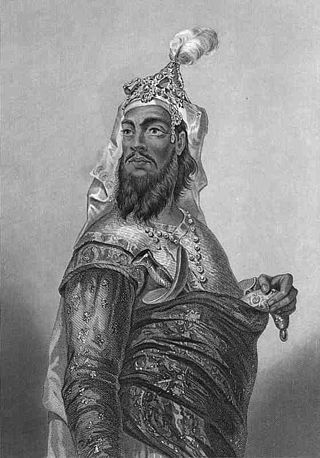
Kunwar Singh, also known as Babu Kunwar Singh was a chief organiser of the Indian Rebellion of 1857 from the Bhojpur region of Bihar. He was originally the ruler of Jagdishpur estate. He led a selected band of armed soldiers against the troops under the command of the British East India Company.
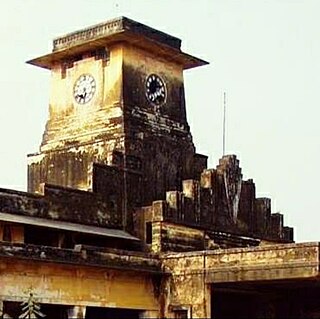
The Bettiah Raj was the second-largest zamindari in the Bettiah region of Bihar, India. It generated annual land revenue rentals of more than 2 million rupees.

Garhwal kingdom was an independent Himalayan kingdom in the current north-western Himalayan state of Uttarakhand, India, founded in 823 CE by Kanak Pal the progenitor of the Panwar dynasty that ruled over the kingdom uninterrupted until 1803 CE.

Jind State was a princely state located in the Punjab and Haryana region of north-western India. The state was 3,260 km2 (1,260 sq mi) in area and its annual income was Rs.3,000,000 in the 1940s. This state was founded and ruled by Sidhu Sikhs.
Negi is a title of Pahadi Rajput or Thakur. The Negi title originated from the word ‘nek’ which means ‘righteous’. This title was conferred by kings, warriors, and ministers. Individuals holding the Negi title were entrusted with the task of collecting taxes from villages. They were given a percentage of the amount collected as remuneration .Similar to the title or the surname of "Chaudhary", "Thakur", "Rana", "Negi" was adopted or mostly given as an honor to the #Kshatriyas who migrated from their homelands of Rajasthan to hills of Uttarakhand and Himachal. origin found in the Indian states of Uttarakhand, Himachal Pradesh and Jammu.
Ganesh Pandey or Ganesa Pande
The Kunwar family was a noble Khas-Chhetri family in the Gorkha Kingdom and the Kingdom of Nepal. The Kunwars were linked to the Thapa dynasty and family of Amar Singh Thapa by marital lineages and, thus, to Pande dynasty through the Thapa dynasty. Three branches of the Kunwars; Ramakrishna, Jayakrishna and Amar Singh Kunwar were formed with opposite political aspirations. Bal Narsingh Kunwar supported Mukhtiyar Bhimsen Thapa while Chandrabir Kunwar supported Bada Kaji Amar Singh Thapa due to their marital relations with those families. Later, the Ramakrishna section of the family including Amarsingh established the Rana dynasty of Nepal and styled themselves as Rana Rajputs while Jayakrishna most section remained as Kunwars.
Battle of Khurbura or Battle of Khudbuda also known as Gorkha-Garhwal War occurred in May 1804 near modern-day village of Dehradun, Khurbura 30.3256°N 78.0267°E. The battle is regarded as the first major attack in the history of Garhwal Kingdom that triggered between Kingdom of Nepal forces and Maharaja Pradyumna Shah, and continued for 13 days until the Garhwal king was defeated. It is chiefly regarded the only defeat of Pradyumna Shah's life and the victory of Gorkhali forces under Kingdom of Nepal.

Gadharona Balaji Temple is a temple in Gadharona village near Landhaura town of district Haridwar Uttarakhand, in which the idol of Lord Hanuman is installed. The temple is from ancient times.
References
- ↑ Raheja, Gloria Goodwin (15 September 1988). The Poison in the Gift: Ritual, Prestation, and the Dominant Caste in a North Indian Village (Page_3). University of Chicago Press. p. 3. ISBN 978-0-226-70729-7.
- ↑ Garhwal Himalaya: Nature, Culture & Society - Page 24. TransMedia. 2001. p. 24. ISBN 978-81-900807-4-3.
he with the help of Ram Dayal Singh Gurjar ( Raja of Landhore ) made a final attempt in May 1805 at Khurbura.
- ↑ Sikh Domination of the Mughal Empire Vol 3, p. 246
- ↑ Dirk H.A. Kolff: Grass in Their Mouths: The Upper Doab of India Under the Company's Magna Charta, 1793-1830 p. 462
- ↑ Singh, David Emmanuel (31 August 2012). Islamization in Modern South Asia: Deobandi Reform and the Gujjar Response. Walter de Gruyter. ISBN 978-1-61451-185-4.
- ↑ Rawat, A.S. (2002). Garhwal Himalaya A Study in Historical Perspective. Indus Publishing House. p. 64
- ↑ Bates, Crispin (31 March 2013). Mutiny at the Margins: New Perspectives on the Indian Uprising of 1857: Volume I: Anticipations and Experiences in the Locality. SAGE Publishing India. ISBN 978-81-321-1589-2.